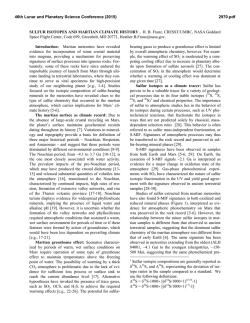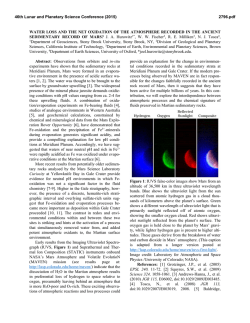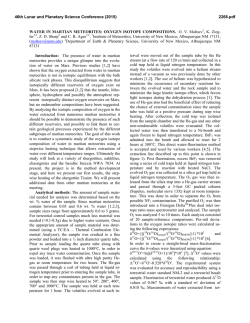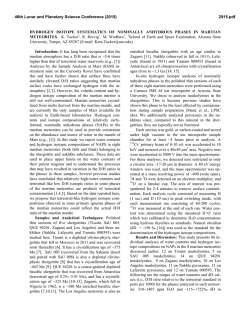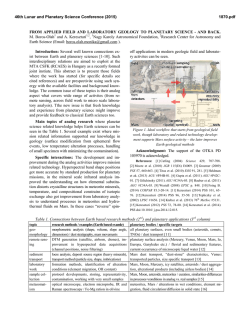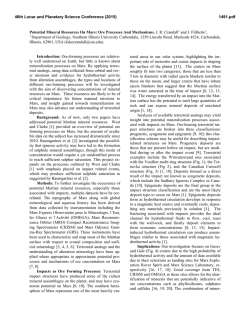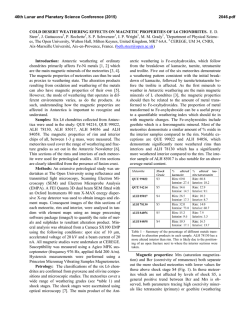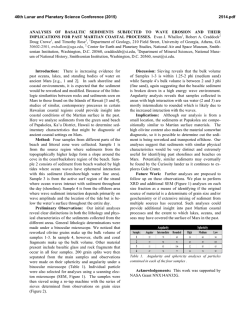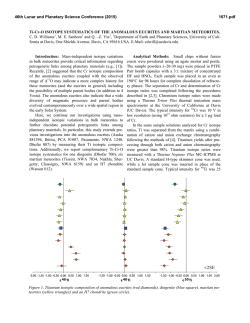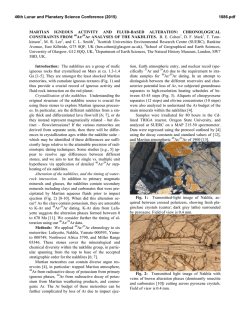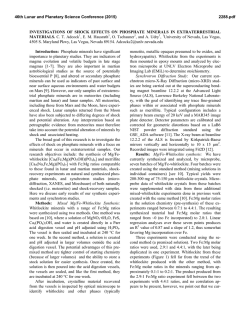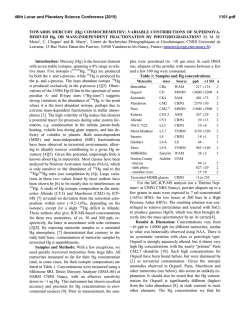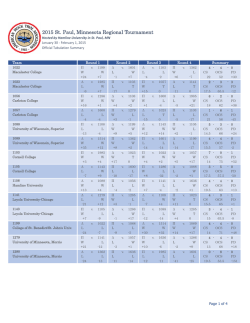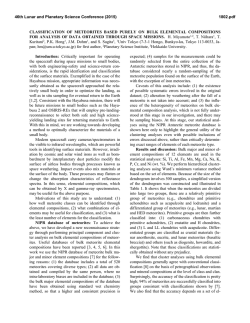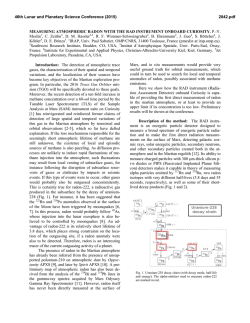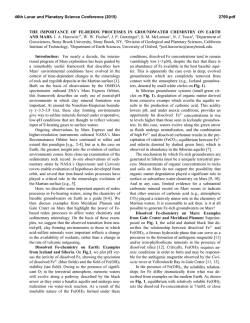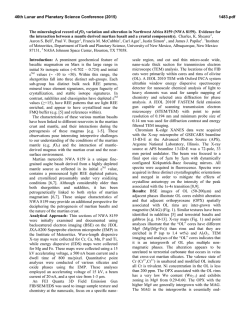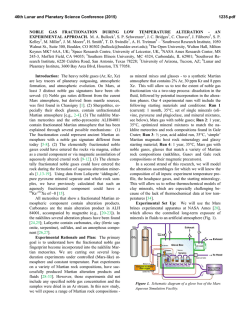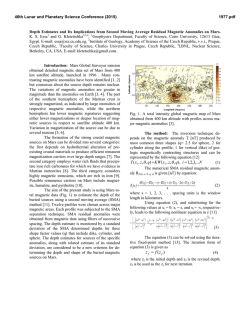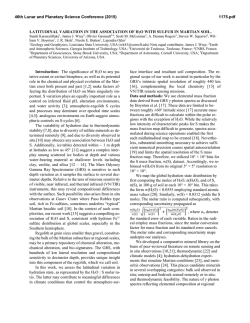
weathering-induced fragmentation as a possible contributor to
46th Lunar and Planetary Science Conference (2015) 2881.pdf WEATHERING-INDUCED FRAGMENTATION AS A POSSIBLE CONTRIBUTOR TO ANOMALOUS STONY METEORITE SCARCITY ON MARS – INSIGHTS FROM ANTARCTICA AND MER. J. W. Ashley1, M. A. Velbel2, and M. P. Golombek1; 1Jet Propulsion Laboratory, California Institute of Technology, Pasadena, CA 91109 ([email protected]); 2Department of Geological Sciences, Michigan State University, East Lansing, MI 48824-1115. Introduction: The emerging subdiscipline of martian meteoritics currently involves the in-situ study of exogenic rocks found by roving spacecraft on the martian surface. Because of meteorite sensitivities to mineral-water interactions, their chemical weathering in equatorial martian environments carries significance for studies of water occurrence and behavior, calibration of climate models, and associated astrobiological questions [1,2]. The inventory of confirmed and candidate meteorites found on Mars by the Spirit, Opportunity, and Curiosity rovers currently numbers 20 at minimum [2-4]. This is a non-trivial fraction of the total number of rocks studied on Mars, and demonstrates the commonality of non-indigenous materials on the martian surface. Significantly, this suite of rocks consists solely of iron and probable stony-iron varieties [however, see 5]. Chondritic and achondritic meteorites, which comprise some 94% of Earth-based falls, are anomalously absent from the martian find inventory. Occasional impactor survivability is demonstrated by the unambiguous presence of some meteorites. However even at low entry velocities, there may be survivability biases favoring stronger irons over weaker stony fragments [6]. The most likely explanation for the stony discrepancy oberved in the rover reconnaissance inventory is a selection bias that favors identification of irons, not unlike that observed historically for Earth-based finds [3]. The stony-iron finds (Barberton Cobbles [e.g., 5,7]) are a special case, possibly involving a single-fall strewn field [8]. Selection bias could be largely a function of size when rover operations and science objectives tend to favor cobble-sized and larger rock targets. Possible factors affecting size for stony meteorites include fragmentation from 1) breakup during atmospheric entry, 2) impact, and 3) post-fall weathering processes at the martian surface. Here we explore the latter possibility using ordinary chondrites (OCs) recovered from a Mars-analog environment. Background: Examples of post-fall iron oxide and/or oxyhydroxide coatings have been found on Meridiani Planum iron meteorites Heat Shield Rock, Block Island, Shelter Island, and Oileán Ruaidh by the Opportunity rover [2,3]. These are interpreted to have formed during recent martian epochs from direct contact with water (probably as ice) [2]. Oxides have also been found within the Barberton Cobble suite of stonyiron candidates on Mars [7,8]. Any OCs present may share comparable exposure histories, depending on arrival times. We look at the effects of lowtemperature, low water/rock ratio weathering condi- tions on OCs in the Mars-analog Antarctic environment to see whether inferring similarities with the martian situation is appropriate. While not yet demonstrated, we suspect that a strong case can be made for considering an OC fragment in a sample return project as reference material for qualifying recent (Amazonianage), and therefore subtle, mineral-water interactions at the martian surface. They may be more sensitive indicators of such reactions than indigenous materials. Thus identifying the missing chondritic component on Mars becomes a matter of some importance. 19 Unstained silicates Oxyhydroxides Unstained Metal 1 mm silicates Oxyhydroxides 1 mm ALH81031 ALH81031 ALH77230 ALH77230 Metal Oxyhydroxides Oxyhydroxides Unstained silicates 1 mm LEW85322 LEW85322 Unstained silicates 1 mm ALH77233 ALH77233 Figure 1.Photomicrographs Photomicrographs in plane light of Figure 2.1. of weathering categoryand C, O polarized chondrite microprobe mounts from OC the Antarctic collection.mounts Images show reduced metaltypical grains examAntarctic microprobe illustrating (opaque) and their oxyhydroxide weathering products, present as both wellples of secondary limonite (probably oxyhydroxide) alteracrystallized minerals in direct contact with parent grains, and as volumetrically low stain materials. interpreted ALH77230 is in cross-polarized light; all others are in primary plain tion products as pseudomorphic after light. Sections have not been cut to standard 30 µm thicknesses. metal grains (opaque in transmitted light). Methods: OCs comprise some 82 percent of terrestrial falls [9], and can thus be considered representative of the missing stony fraction on Mars. They contain Fe-Ni metal and iron sulfide grains in abundances ranging from 13.6 (L OCs) to ~24 (H OCs) weight percent. These are the first materials to oxidize in the presence of water in abundant or trace amounts [10]. 19 Point count modal analyses using petrographic microscopy with an automated stage were performed on microprobe mounts obtained through the NASA Johnson Space Center for 19 weathering category C Antarctic OCs. Samples were selected to represent the most severely weathered fraction of Antarctic finds. Five hundred points per sample were counted, representing 1) the dominating silicate mineralogy, 2) metal and sulfide grains (opaque in transmitted light), and 3) secondary limonite products interpreted as being opaque- 46th Lunar and Planetary Science Conference (2015) pseudomorphic limonite (OPL). X-ray diffraction on bulk samples suggested that these products include goethite and akaganéite while thermal emission spectroscopy identified absorption bands consisted with lepidocrocite (in LEW86015 only). Results: Modal analytical data are presented in Figure 2. Preterrestrial (unweathered) OC would plot along the right border, and migrate from right to left as OPL (alteration products) replaced opaque grains. Arrow A represents the case where opaque minerals alter pseudomorphically to OPL products with no volume change. However, mineral unit cell volume calculations show a ≳3-fold volumetric increase for some oxyhydroxides relavite to their parent metals kamacite and taenite (if Fe is immobile during weathering). Thus where pore spaces are available (near rock surfaces and within fractures) we would expect to see some expansion of OPL to fill these voids, and corresponding departures from line A in Figure 2. Lines paralleling arrow A’ represent limits in vertical (top-down) movement for any given datapoint because to cross such a line would mean that metal abundances had increased. Given that some fracture porosity is present in most OCs, the most likely path of migration for each data point is along a line intermediate between arrows A and A’ (black arrow B). Such a path is supported by petrographic evidence, and could represent a dilatation of the rock as a whole. Thus on a ternary diagram, where volume is conserved, the arrow B example path is the projection onto two dimensions of a threedimensional tetrahedron where the fourth end-member is volume change. 2881.pdf duction, which balances its volumetric increase with the tensile strength of the rock mass. Such passivation would be a metastable state reflecting conditions between episodes of fracture creation or enlargement. Fracture density appears to be important for the longterm preservation of OC rocks as oxide production will encourage their dilatation and breakup. A similar effect has been observed in hot desert environments [11], and thus appears to be more a function of water availability than of temperature. Opportunity has imaged a number of low-velocity impact sites in its traverse from Eagle to Endeavour craters. Dark pebbles littering the rims of Resolution, Discovery, and Concepción craters are interpreted as fragments of their respective impactors [12]. Other materials present anomalous morphologies and lusters suggestive of meteorites (Figure 3). These may well represent the “missing” stony meteorite fraction on Mars, and their small relative size (cm-scale and smaller) may result from a combination of impact and weathering-induced fragmentation. Complete disintegration must also be considered a possible explanation for the lack of stony meteorites on Mars. Silicates A B Figure 3. False color Pancam image of meteorite candidate Canegrass, imaged on Opportunity sol 3346. The rock appears to be involved in a disintegration process consistent with that discussed in this study. A’ OPL Opaque grains Figure 2. Ternary diagram presenting modal analysis of 19 weathering category C Antarctic OCs. Linear trend among data points suggests passivation of limonite production. The clear linear data point trend in Figure 2 is not strickly parallel to any ternary boarder, and therefore cannot be attributed to a simple variability in any single pair of end-member components. It may indicate a temporary state of pressure equilibrium for OPL pro- References: [1] Webster C. R. et al. (2014) Science. [2] Ashley J. W. et al. (2011) J. Geophys. Res., 116, E00F20. [3] Ashley J. W. (2014) GSA abs. #202-14. [4] Schröder C. et al. (2008) J. Geophys. Res., 113, E06S22. [5] Schröder C. (2015) LPSC XLVI, this conference. [6] Chappelow J. E. and Golombek M. P. (2010) J. Geophys. Res., 113, E06S22. [7] Fleischer I. et al. (2011) MAPS, 46, issue 1, 21-34. [8] Schröder C. et al. (2010) J. Geophys. Res., 115, E00F09. [9] Dodd R. T. (1081) Meteorites: A Petrologic Chemical Synthesis, Cambridge, 386 pp. [10] Velbel M. A. (2014) MAPS, 49, issue 2, 154-171. [11] Bland et al. (1998) Geochim. Cosmochim. Acta, 62, 3169-3184. [12] Golombek et al. (2010) J. Geophys. Res. 115, E00F08.
© Copyright 2025
